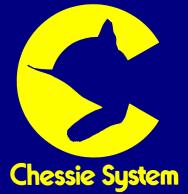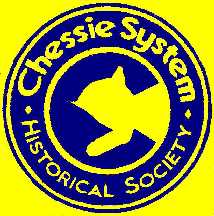In
railroad circles, information about the original railroad is referred
to as "prototype" information. The prototype information shown
here is presented to inform members and non-members about the history
of the actual railroad during the Chessie Era (1972-1986). Any
information about modeling the Chessie System is on the "Modeling
Information" page. Any information about surviving equipment is
on the "Preserved Equipment" and "Preservation Projects" pages.
History:
The Chessie System was a holding company
that owned the stock of three railroads, the Baltimore & Ohio
(B&O), the Chesepeake
& Ohio (C&O) and the Western Maryland (WM). Each of the
three
predecessor railroads had rich histories of their own. The
B&O
was the first common carrier railroad company in the US, founded in
1827. The C&O
was the most financially sound of the three. It had made a strong
name for itself as a premier coal-hauling railroad. The WM was
the
smallest, but probably the proudest. The WM had a reputation for
being a first class operation right to the end. They tended to
have
the oldest equipment, but it was in such good shape, some referred to
the
WM as a working museum.
To make things confusing, before the
Chessie System, the WM was controlled by the B&O, who in turn was
in
a "partnership" with the C&O. These relationships began in
the 50's but didn't operate under a unified image until the Chessie
System paint jobs were created.
The first locomotives, 1977cs-b&o and GM50cs-b&o, were
displayed
in 1972, officially kicking off the Chessie Era. Starting in 1972
the Chessie paint scheme was applied to all new locomotives, most of
the
older locomotives, most of the freight cars, and numerous other
vehicles.
It is important to note that throughout
the Chessie Era each railroad operated as separate railroads, but
shared
equipment. There were never any "Chessie" reporting marks, since
the Chessie System company didn't own any of their own equipment.
The parent roads kept ownership of them. Any equipment that was
purchased
by Chessie was assigned to a specific railroad and carried that
railroad's
reporting marks. Each old locomotive or freight car painted with
the Chessie logo retained its original owners reporting marks, ex:
B&O,
C&O, WM. Eventually the companies worked more and more
together. They eventually combined the B&O and WM seniority
rosters, routed trains over each others railroads to get more efficient
routes and abandoned duplicate trackage. Today under CSX, they
are all one company.
CSX, standing for Chessie(C), Seaboard(S),
and More(X), is another holding company that owns the elements of
Chessie
and the Seaboard family. Seaboard is made up of Seaboard Coast
Line,
Atlantic Coast Line, Louisville & Nashville, and others. CSX
equipment
will not be shown on this site, except if it still wears the Chessie
logo
or paint scheme. Those pictures are shown as an example of what
is
out there today riding the rails.
The first CSX painted locomotive rolled
out in 1986, therefore closing the book on the Chessie Era. Don't
dismay though, as of this writing, there are still hundreds of freight
cars rolling across CSX. Unfortunately the last Chessie
locomotive
working for CSX was retired in 2003. There are however Chessie
painted
locomotives working for shortlines in West Virginia, Georgia, and
Indiana.
Additionally, railroads are not quick in painting
their equipment into the latest corporate image. 28 years have
passed
since the inception of Chessie, and there is still one locomotive and
some
freight cars painted in C&O and B&O paint (pre-1972)!
Next time you see a train rolling,
look for that famous Chessie logo. It is still out there.
Ches-C
Logo:
 The logo created for the Chessie System was a stylized version of a
1933 lithograph depicting a sleeping kitten. The C&O railroad
was nicknamed the "Chessie" line, short for "Chesapeake". Since
"Chessie" is also a type of cat, the use of the sleeping kitten was
appropriate to market the high quality passenger service. "Sleep
like a Kitten" was the motto used by the C&O through the
30's. In the 40's, "Chessie" advertisements even showed her
husband, "Peake". "Chessie" and "Peake" even had some unnamed
kittens in the ads.
The logo created for the Chessie System was a stylized version of a
1933 lithograph depicting a sleeping kitten. The C&O railroad
was nicknamed the "Chessie" line, short for "Chesapeake". Since
"Chessie" is also a type of cat, the use of the sleeping kitten was
appropriate to market the high quality passenger service. "Sleep
like a Kitten" was the motto used by the C&O through the
30's. In the 40's, "Chessie" advertisements even showed her
husband, "Peake". "Chessie" and "Peake" even had some unnamed
kittens in the ads.
When the new holding company was looking for a name
and logo, the "Chessie System" title won out and the motto was adjusted
to "Purr-fect Transporation".
The "Ches-C" logo took the original image of the
sleeping kitten and put it inside the letter C. This logo was put
on all Chessie painted equipment. It also depicts the front of
any locomotive.
Locomotives:
Rosters of locomotives can change daily on a
real
railroad. Purchases, accidents and retirements put the list of
available locomotives in constant flux. Generally speaking the
Chessie System roster was about 2,100 locomotives. Approximately
1,000 C&O, 1,000 B&O and 100 WM.
Multi-purpose or road locomotives were about 1,900
of the 2,100. The remaining 200 were switching locomotives used
in yard service.
About 1,900 were four axle units and 300 were six
axle units. This is a marked change from locomotive fleets of
today, that are dominated by six axle power.
Chessie's rosters are also dominated by General
Motors (EMD) locomotives. Of the 2,100, about 2,000 were EMD and
100 were General Electric (GE) locomotives. The Chessie System
also rostered about 10 American Locomotive (ALCO) switchers.
Freight
Cars:
Freight car rosters also changed daily on a real railroad. As a
snap shot in time, Chessie owned 115,701 freight cars. They were
broken down as follows:
69,227 Open Hoppers
3,773 Plain Boxcars
13,689 Equipped Boxcars
10,581 Plain Gondolas
3,136 Equipped Gondolas
8,027 Covered Hoppers
977 Flat Cars
3,787 Trailers (these are semi-trailers that are counted in the total)
1,986 Multi-Levels
518 Miscellaneous
Cabooses:
Cabooses were used on almost all trains at the start of the Chessie Era
(1972) and were phased out of most trains by the end (1986).
Cabooses are still used on trains that require long backward
moves. The WM had only one class of caboose (C-13A). This
is considered a Northeast style caboose. Their 105 or so cabooses
were all the same type. The B&O rostered mostly bay window
cabooses (C-24, 26, 26A, 27, 27A), but also rostered steel cupola and
wagon top. The C&O rostered steel cupola and wide visions
mostly, but did have some ex-WM Northeasts and some C27A bay windows.
Chessie was unique in that they had several uniqely
painted cabooses used as safety slogan rolling billboards. Each
had its own slogan and came in colors such as purple, brown, light
blue, red, orange, yellow, green, royal blue, navy blue, white,
chartruse, etc. They also painted six cabooses in a Careful Car
Handling orange paint job to promote better switching practices.
There was also one green caboose at Cumberland for local displays on
safety.
Misc.
Equipment:
As any Class I railroad there was a full collection of Maintenace of
Way equipment including Big Hook Cranes, Difco Side Dump Hoppers and
Jordan Spreaders. Much of this equipment was in the old C&O
standard of painting MofW equipment green with yellow markings.
 PROTOTYPE INFORMATION
PROTOTYPE INFORMATION
 The logo created for the Chessie System was a stylized version of a
1933 lithograph depicting a sleeping kitten. The C&O railroad
was nicknamed the "Chessie" line, short for "Chesapeake". Since
"Chessie" is also a type of cat, the use of the sleeping kitten was
appropriate to market the high quality passenger service. "Sleep
like a Kitten" was the motto used by the C&O through the
30's. In the 40's, "Chessie" advertisements even showed her
husband, "Peake". "Chessie" and "Peake" even had some unnamed
kittens in the ads.
The logo created for the Chessie System was a stylized version of a
1933 lithograph depicting a sleeping kitten. The C&O railroad
was nicknamed the "Chessie" line, short for "Chesapeake". Since
"Chessie" is also a type of cat, the use of the sleeping kitten was
appropriate to market the high quality passenger service. "Sleep
like a Kitten" was the motto used by the C&O through the
30's. In the 40's, "Chessie" advertisements even showed her
husband, "Peake". "Chessie" and "Peake" even had some unnamed
kittens in the ads.